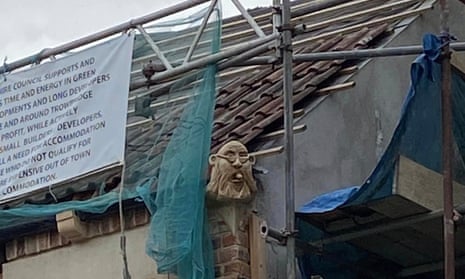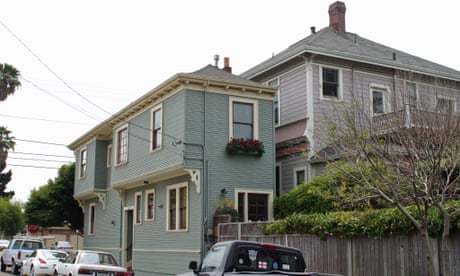ARCHITECTURE
‘Spite buildings’ intended to cause irritation have a long and proud history from Beirut to Buenos Aires
Caroline Davies
THE GUARDIAN
Tue 26 Sep 2023
 Trowbridge’s town council leader, Stewart Palmen, has found himself the subject of a carved addition to the roof of an aggrieved builder. Photograph: Stewart Palmen
Trowbridge’s town council leader, Stewart Palmen, has found himself the subject of a carved addition to the roof of an aggrieved builder. Photograph: Stewart Palmen
From view-blocking houses to nose-thumbing towers, revenge is the mortar that binds the bricks in “spite buildings”, constructed with the sole aim of causing irritation.
The Al Ba’sa (The Grudge) house in Beirut, was built on a sliver of land in 1954 by one feuding brother merely to obstruct the sea view of the other. At just 60cm wide at its narrowest point, it remains the thinnest habitable building in the city, and has become a tourist attraction.
The Inat Kuca (Spite House) in Sarajevo was built in 1879 after its owner refused to move to make way for a planned town hall unless his original home was dismantled brick by brick and reconstructed across the river. The house, now a restaurant, is seen as a symbol of Bosnian defiance against the Austrian-Hungarian empire.
Now we can add to this esteemed list “the Gargoyle”, a foot-high unflattering stone carving of the Trowbridge town council leader, Stewart Palmen, added by an angry builder to the roof of a building at the centre of a Wiltshire planning dispute. If it was designed to insult, however, it seems to have backfired, with Palmen declaring he would like it for his garden.

Spite buildings: when human grudges get architectural – in pictures
“It’s very funny. It’s great,” said Dr Timothy Brittain-Catlin, who runs the architecture apprenticeship course at Cambridge University. As an example of “spite’ architecture, it’s a classic: motivated by malice, as public a protest as is possible, and, like all good spite architecture, a daily reminder of a painful slight.
Brittain-Catlin thinks spite buildings do add to the world of architecture. “I think that they show that the purpose of building is not just the functional, practical thing, which is how many people see it. There are many things buildings can do. They can prove a point, which is what these buildings are doing. They are a demonstration of your power,” he said.
Among his favourites is a column by the architect Quinlan Terry, commissioned by former Conservative party treasurer Lord McAlpine for the gardens of West Green House in Hampshire. Positioned for all to see by the road, it was McAlpine’s response to Labour’s threat of a wealth tax, with its inscription in Latin, translating as: “This monument was built with a large sum of money, which would have otherwise fallen, sooner or later, into the hands of the tax-gatherer.”
The 77-metre (253ft) Wainhouse Tower in Calderdale, West Yorkshire, built from 1871-75, is said to owe its great height and viewing platform to the factory owner John Wainhouse’s desire to annoy his neighbour and local dignitary Sir Henry Edwards, who had boasted of his estate being the most private in Halifax, and which was now overlooked by the folly.
Neighbour disputes have led to many an imaginative protest. An argument over a fence in South Wootton made headlines when one man ended up erecting a large sign reading “Ugly Fence House” in anger at his neighbours’ fencing. One woman famously painted red and white “candy stripes” on the property she bought for £15m in South End, Kensington, after her initial plans to redevelop were challenged by neighbours and rejected by Kensington and Chelsea council.
Often spite buildings are the result of inheritance disputes, such as the Skinny House, Boston, built in about 1874, when one man returning from the American civil war discovered his brother had taken up most of the plot they had inherited, so constructed his own skinny house on the remaining land, blocking out the sunlight and his brother’s view in the process.
One of the most impressive is the 33-floor Kavanagh Building in Buenos Aires. In 1936, Cora Kavanagh, a millionaire whose lover, a member of the aristocratic Anchorena family, was forced to break off their relationship by his family, instructed an architect to design a skyscraper that would block the Anchorenas’ view of the church they had built.
Oliver Wainwright, the Guardian’s architecture and design critic, says: “The history of cities is a history of spite – they are grudges and vendettas wrought in bricks and mortar. Landowners have always tried to get one over on their neighbours, whether it’s the Tuscan merchants competing with ever taller towers in San Gimignano, or the bristling shafts of London’s Square Mile blocking each other’s views, or the sun-eclipsing leylandii hedges of feuding English suburbia.”
“It seems that the built environment is becoming increasingly spiteful, from the proliferation of anti-homeless spikes and anti-skateboarding studs, to the recent legal ruling that has allowed residents of multimillion-pound Thameside flats to have half of Tate Modern’s roof deck shut down. Despite the efforts of the planning system, the sacred right of the property owner always manages to trump the wider public good.”
 Trowbridge’s town council leader, Stewart Palmen, has found himself the subject of a carved addition to the roof of an aggrieved builder. Photograph: Stewart Palmen
Trowbridge’s town council leader, Stewart Palmen, has found himself the subject of a carved addition to the roof of an aggrieved builder. Photograph: Stewart PalmenFrom view-blocking houses to nose-thumbing towers, revenge is the mortar that binds the bricks in “spite buildings”, constructed with the sole aim of causing irritation.
The Al Ba’sa (The Grudge) house in Beirut, was built on a sliver of land in 1954 by one feuding brother merely to obstruct the sea view of the other. At just 60cm wide at its narrowest point, it remains the thinnest habitable building in the city, and has become a tourist attraction.
The Inat Kuca (Spite House) in Sarajevo was built in 1879 after its owner refused to move to make way for a planned town hall unless his original home was dismantled brick by brick and reconstructed across the river. The house, now a restaurant, is seen as a symbol of Bosnian defiance against the Austrian-Hungarian empire.
Now we can add to this esteemed list “the Gargoyle”, a foot-high unflattering stone carving of the Trowbridge town council leader, Stewart Palmen, added by an angry builder to the roof of a building at the centre of a Wiltshire planning dispute. If it was designed to insult, however, it seems to have backfired, with Palmen declaring he would like it for his garden.

Spite buildings: when human grudges get architectural – in pictures
“It’s very funny. It’s great,” said Dr Timothy Brittain-Catlin, who runs the architecture apprenticeship course at Cambridge University. As an example of “spite’ architecture, it’s a classic: motivated by malice, as public a protest as is possible, and, like all good spite architecture, a daily reminder of a painful slight.
Brittain-Catlin thinks spite buildings do add to the world of architecture. “I think that they show that the purpose of building is not just the functional, practical thing, which is how many people see it. There are many things buildings can do. They can prove a point, which is what these buildings are doing. They are a demonstration of your power,” he said.
Among his favourites is a column by the architect Quinlan Terry, commissioned by former Conservative party treasurer Lord McAlpine for the gardens of West Green House in Hampshire. Positioned for all to see by the road, it was McAlpine’s response to Labour’s threat of a wealth tax, with its inscription in Latin, translating as: “This monument was built with a large sum of money, which would have otherwise fallen, sooner or later, into the hands of the tax-gatherer.”
The 77-metre (253ft) Wainhouse Tower in Calderdale, West Yorkshire, built from 1871-75, is said to owe its great height and viewing platform to the factory owner John Wainhouse’s desire to annoy his neighbour and local dignitary Sir Henry Edwards, who had boasted of his estate being the most private in Halifax, and which was now overlooked by the folly.
Neighbour disputes have led to many an imaginative protest. An argument over a fence in South Wootton made headlines when one man ended up erecting a large sign reading “Ugly Fence House” in anger at his neighbours’ fencing. One woman famously painted red and white “candy stripes” on the property she bought for £15m in South End, Kensington, after her initial plans to redevelop were challenged by neighbours and rejected by Kensington and Chelsea council.
Often spite buildings are the result of inheritance disputes, such as the Skinny House, Boston, built in about 1874, when one man returning from the American civil war discovered his brother had taken up most of the plot they had inherited, so constructed his own skinny house on the remaining land, blocking out the sunlight and his brother’s view in the process.
One of the most impressive is the 33-floor Kavanagh Building in Buenos Aires. In 1936, Cora Kavanagh, a millionaire whose lover, a member of the aristocratic Anchorena family, was forced to break off their relationship by his family, instructed an architect to design a skyscraper that would block the Anchorenas’ view of the church they had built.
Oliver Wainwright, the Guardian’s architecture and design critic, says: “The history of cities is a history of spite – they are grudges and vendettas wrought in bricks and mortar. Landowners have always tried to get one over on their neighbours, whether it’s the Tuscan merchants competing with ever taller towers in San Gimignano, or the bristling shafts of London’s Square Mile blocking each other’s views, or the sun-eclipsing leylandii hedges of feuding English suburbia.”
“It seems that the built environment is becoming increasingly spiteful, from the proliferation of anti-homeless spikes and anti-skateboarding studs, to the recent legal ruling that has allowed residents of multimillion-pound Thameside flats to have half of Tate Modern’s roof deck shut down. Despite the efforts of the planning system, the sacred right of the property owner always manages to trump the wider public good.”
No comments:
Post a Comment